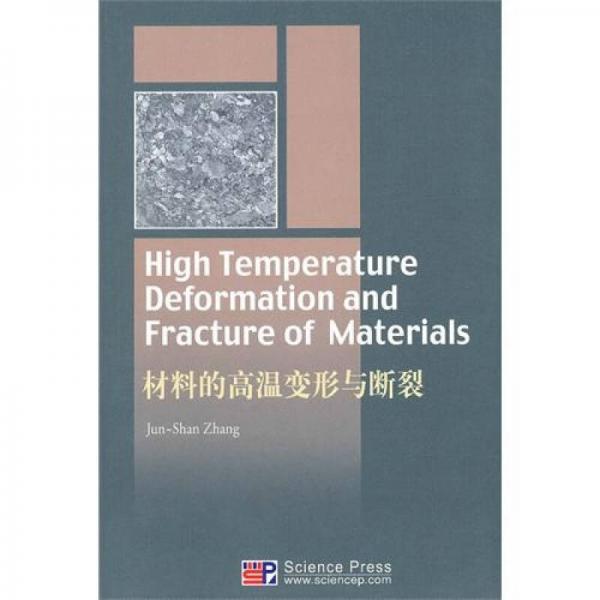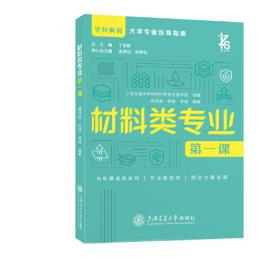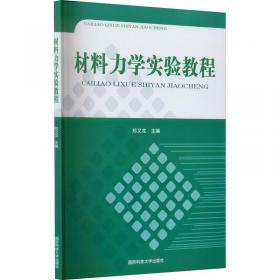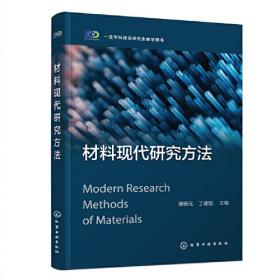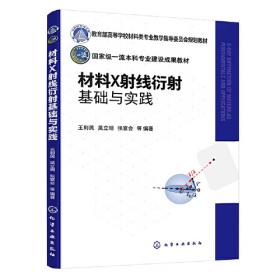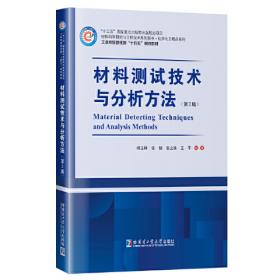材料的高温变形与断裂(英文版)
出版时间:
2010-07
版次:
1
ISBN:
9787030275400
定价:
88.00
装帧:
平装
开本:
16开
纸张:
胶版纸
页数:
365页
字数:
483千字
正文语种:
英语
-
《材料的高温变形与断裂(英文版)》内容分两篇共25章。上篇为高温变形篇,包括金属与合金蠕变的宏观规律、蠕变位错亚结构、纯金属蠕变、固溶体合金蠕变、第二相粒子强化合金蠕变、扩散蠕变、超塑性以及多轴蠕变等内容,重点论述蠕变过程中位错与各种晶体缺陷的交互作用、蠕变微观机制以及蠕变物理模型和理论。下篇为高温断裂篇,包括蠕变空洞形核和长大、蠕变裂纹扩展、蠕变损伤与断裂的评价与预测、高温低周疲劳断裂、蠕变疲劳交互作用以及材料的高温环境损伤等内容,从微观、宏观和唯象三个层次论述了高温断裂理论及其工程应用。
《材料的高温变形与断裂(英文版)》可作为高等院校材料学科研究生教学参考书,也可供材料、固体物理和力学专业教师及科研人员参考。 Authorcontactdetails
Preface
PartIHighTemperatureDeformation
1CreepBehaviorofMaterials
1.1CreepCurve
1.2StressandTemperatureDependenceofCreepRate
1.3StackingFaultEnergyEffect
1.4GrainSizeEffect
References
2EvolutionofDislocationSubstructuresDuringCreep
2.1ParametersofDislocationSubstructuresandTheirMeasurements
2.2EvolutionofDislocationSubstructureduringCreep
2.3DislocationSubstructureofSteadyStateCreep
2.4InhomogeneousDislocationSubstructureandLong-RangeInternalStress
References
3DislocationMotionatElevatedTemperatures
3.1ThermallyActivatedGlideofDislocation
3.2MeasurementofInternalStress
3.3ClimbofDislocations
3.4BasicEquationsofRecoveryCreep
3.5MechanismsofRecovery
References
4Recovery-CreepTheoriesofPureMetals
4.1Introduction
4.2WeertmanModel
4.3ModelsConsideringSub-Boundary
4.4ModelsBasedonDislocationNetwork
4.5CreepModelBasedontheMotionofJoggedScrewDislocation
4.6SummaryofRecoveryCreepModels
4.7SoftandHardRegionCompositeModel
4.8Harper-DornCreep
References
5CreepofSolidSolutionAlloys
5.1InteractionBetweenDislocationandSoluteAtom
5.2CreepBehaviorofSolidSolutionAlloys
5.3ViscousGlideVelocityofDislocations
5.4CreepControlledbyViscousGlideofDislocations
References
6CreepofSecondPhaseParticlesStrengthenedMaterials
6.1Introduction
6.2Arzt-AshbyModel
6.3CreepModelBasedonAttractiveParticle-DislocationInteraction
6.4InteractionofDislocationwithLocalizedParticles
6.5MechanismsofParticleStrengthening
6.6GrainBoundaryPrecipitationStrengthening
References
7CreepofParticulatesReinforcedCompositeMaterial
7.1CreepBehaviorofParticulatesReinforcedAluminiumMatrixComposites
7.2DeterminationofThresholdStress
7.3CreepMechanismsandRoleofReinforcementPhase
References
8HighTemperatureDeformationofIntermetallicCompounds
8.1CrystalStructures,DislocationsandPlanarDefects
8.2DislocationCoreStructure
8.3SlipSystemsandFlowStressesofIntermetallicCompounds
8.4CreepofInterrnetallicCompounds
8.5CreepofCompound-BasedODSAlloys
References
9DiffusionalCreep
9.1TheoryonDiffusionalCreep
9.2AccommodationofDiffusionalCreep.GrainBoundarySliding
9.3DiffusionalCreepControlledbyBoundaryReaction
9.4ExperimentalEvidencesofDiffusionalCreep
10Superplasticity
10.1StabilityofDeformation
10.2GeneralCharacteristicsofSuperplasticity
10.3MicrostructureCharacteristicsofSuperplasticity
10.4GrainBoundaryBehaviorsinSuperplasticDeformation
10.5MechanismofSuperplasticDeformation
10.6ThemaximumStrainRateforSuperplasticity
References
11MechanismsofGrainBoundarySliding
11.1Introduction
11.2IntrinsicGrainBoundarySliding
11.3ExtrinsicGrainBoundarySliding
References
12MultiaxialCreepModels
12.1UniaxialCreepModels
12.2MutiaxialCreepModels
12.3MutiaxialSteadyStateCreepModel
12.4StressRelaxationbyCreep
References
PartIIHighTemperatureFracture
13NucleationofCreepCavity
13.1Introduction
13.2NucleationSitesofCavity
13.3TheoryofCavityNucleation
13.4CavityNucleationRate
References
14CreepEmbrittlementbySegregationofImpurities
14.1NickelandNickel-BaseSuperalloys
14.2Low-AlloySteels
References
15DiffusionalGrowthofCreepCavities
15.1ChemicalPotentialofVacancies
15.2Hull-RimmerModelforCavityGrowth
15.3Speight-HarrisModelforCavityGrowth
15.4TheroleofSurfaceDiffusion
16CavityGrowthbyCoupledDiffusionandCreep
16.1Monkman-GrantRelation
16.2Beer-SpeightModel
16.3Edward-AshbyModel
16.4Chen-Argonmodel
16.5Cocks-AshbyModel
References
17ConstrainedGrowthofCreepCavities
17.1Introduction
17.2RiceModel
17.3Raj-GhoshModel
17.4Cocks-AshbyModel
References
18NucleationandGrowthofWedge-TypeMicrocracks
18.1Introduction
18.2NucleationofWedge-TypeCracks
18.3ThePropagationofWedge-TypeCracks
18.4CrackGrowthbyCavitation
References
19CreepCrackGrowth
19.1Crack-TipStressFieldsinElastoplasticBody
19.2StressFieldatSteady-State-CreepCrackTip
19.3TheCrackTipStressFieldsinTransitionPeriod
19.4VitekModelforCreepCrackTipFields
19.5TheInfluenceofCreepThresholdStress
19.6TheExperimentalResultsforCreepCrackGrowth
References
20CreepDamageMechanics
20.1IntroductiontotheDamageMechanics
20.2DamageVariableandEffectiveStress
20.3KachanovCreepDamageTheory
20.4RabotnovCreepDamageTheory
20.5Three-DimensionalCreepDamageTheory
References
21CreepDamagePhysics
21.1Introduction
21.2LossofExternalSection
21.3LossofInternalSection
21.4DegradationofMicrostructure
21.5DamagebyOxidation
References
22PredictionofCreepRuptureLife
22.1ExtrapolationMethodsofCreepRuptureLife
22.2θProjectionMethod
22.3MaruyamaParameter
22.4ReliabilityofPredictionforCreepRuptureProperty
References
23Creep-FatigueInteraction
23.1CreepFatigueWaveforms
23.2Creep-FatigueFailureMaps
23.3HoldingTimeEffectsonCreep-FatigueLifetime
23.4FractureMechanicsofCreepFatigueCrackGrowth
References
24PredictionofCreep-FatigueLife
24.1LinearDamageAccumulationRule
24.2StrainRangePartitioning
24.3DamageMechanicsMethod
24.4DamageFunctionMethod
24.5EmpiricalMethods
References
25EnvironmentalDamageatHighTemperature
25.1Oxidation
25.2HotCorrosion
25.3Carburization
References
AppendixA
AppendixB
Index
-
内容简介:
《材料的高温变形与断裂(英文版)》内容分两篇共25章。上篇为高温变形篇,包括金属与合金蠕变的宏观规律、蠕变位错亚结构、纯金属蠕变、固溶体合金蠕变、第二相粒子强化合金蠕变、扩散蠕变、超塑性以及多轴蠕变等内容,重点论述蠕变过程中位错与各种晶体缺陷的交互作用、蠕变微观机制以及蠕变物理模型和理论。下篇为高温断裂篇,包括蠕变空洞形核和长大、蠕变裂纹扩展、蠕变损伤与断裂的评价与预测、高温低周疲劳断裂、蠕变疲劳交互作用以及材料的高温环境损伤等内容,从微观、宏观和唯象三个层次论述了高温断裂理论及其工程应用。
《材料的高温变形与断裂(英文版)》可作为高等院校材料学科研究生教学参考书,也可供材料、固体物理和力学专业教师及科研人员参考。
-
目录:
Authorcontactdetails
Preface
PartIHighTemperatureDeformation
1CreepBehaviorofMaterials
1.1CreepCurve
1.2StressandTemperatureDependenceofCreepRate
1.3StackingFaultEnergyEffect
1.4GrainSizeEffect
References
2EvolutionofDislocationSubstructuresDuringCreep
2.1ParametersofDislocationSubstructuresandTheirMeasurements
2.2EvolutionofDislocationSubstructureduringCreep
2.3DislocationSubstructureofSteadyStateCreep
2.4InhomogeneousDislocationSubstructureandLong-RangeInternalStress
References
3DislocationMotionatElevatedTemperatures
3.1ThermallyActivatedGlideofDislocation
3.2MeasurementofInternalStress
3.3ClimbofDislocations
3.4BasicEquationsofRecoveryCreep
3.5MechanismsofRecovery
References
4Recovery-CreepTheoriesofPureMetals
4.1Introduction
4.2WeertmanModel
4.3ModelsConsideringSub-Boundary
4.4ModelsBasedonDislocationNetwork
4.5CreepModelBasedontheMotionofJoggedScrewDislocation
4.6SummaryofRecoveryCreepModels
4.7SoftandHardRegionCompositeModel
4.8Harper-DornCreep
References
5CreepofSolidSolutionAlloys
5.1InteractionBetweenDislocationandSoluteAtom
5.2CreepBehaviorofSolidSolutionAlloys
5.3ViscousGlideVelocityofDislocations
5.4CreepControlledbyViscousGlideofDislocations
References
6CreepofSecondPhaseParticlesStrengthenedMaterials
6.1Introduction
6.2Arzt-AshbyModel
6.3CreepModelBasedonAttractiveParticle-DislocationInteraction
6.4InteractionofDislocationwithLocalizedParticles
6.5MechanismsofParticleStrengthening
6.6GrainBoundaryPrecipitationStrengthening
References
7CreepofParticulatesReinforcedCompositeMaterial
7.1CreepBehaviorofParticulatesReinforcedAluminiumMatrixComposites
7.2DeterminationofThresholdStress
7.3CreepMechanismsandRoleofReinforcementPhase
References
8HighTemperatureDeformationofIntermetallicCompounds
8.1CrystalStructures,DislocationsandPlanarDefects
8.2DislocationCoreStructure
8.3SlipSystemsandFlowStressesofIntermetallicCompounds
8.4CreepofInterrnetallicCompounds
8.5CreepofCompound-BasedODSAlloys
References
9DiffusionalCreep
9.1TheoryonDiffusionalCreep
9.2AccommodationofDiffusionalCreep.GrainBoundarySliding
9.3DiffusionalCreepControlledbyBoundaryReaction
9.4ExperimentalEvidencesofDiffusionalCreep
10Superplasticity
10.1StabilityofDeformation
10.2GeneralCharacteristicsofSuperplasticity
10.3MicrostructureCharacteristicsofSuperplasticity
10.4GrainBoundaryBehaviorsinSuperplasticDeformation
10.5MechanismofSuperplasticDeformation
10.6ThemaximumStrainRateforSuperplasticity
References
11MechanismsofGrainBoundarySliding
11.1Introduction
11.2IntrinsicGrainBoundarySliding
11.3ExtrinsicGrainBoundarySliding
References
12MultiaxialCreepModels
12.1UniaxialCreepModels
12.2MutiaxialCreepModels
12.3MutiaxialSteadyStateCreepModel
12.4StressRelaxationbyCreep
References
PartIIHighTemperatureFracture
13NucleationofCreepCavity
13.1Introduction
13.2NucleationSitesofCavity
13.3TheoryofCavityNucleation
13.4CavityNucleationRate
References
14CreepEmbrittlementbySegregationofImpurities
14.1NickelandNickel-BaseSuperalloys
14.2Low-AlloySteels
References
15DiffusionalGrowthofCreepCavities
15.1ChemicalPotentialofVacancies
15.2Hull-RimmerModelforCavityGrowth
15.3Speight-HarrisModelforCavityGrowth
15.4TheroleofSurfaceDiffusion
16CavityGrowthbyCoupledDiffusionandCreep
16.1Monkman-GrantRelation
16.2Beer-SpeightModel
16.3Edward-AshbyModel
16.4Chen-Argonmodel
16.5Cocks-AshbyModel
References
17ConstrainedGrowthofCreepCavities
17.1Introduction
17.2RiceModel
17.3Raj-GhoshModel
17.4Cocks-AshbyModel
References
18NucleationandGrowthofWedge-TypeMicrocracks
18.1Introduction
18.2NucleationofWedge-TypeCracks
18.3ThePropagationofWedge-TypeCracks
18.4CrackGrowthbyCavitation
References
19CreepCrackGrowth
19.1Crack-TipStressFieldsinElastoplasticBody
19.2StressFieldatSteady-State-CreepCrackTip
19.3TheCrackTipStressFieldsinTransitionPeriod
19.4VitekModelforCreepCrackTipFields
19.5TheInfluenceofCreepThresholdStress
19.6TheExperimentalResultsforCreepCrackGrowth
References
20CreepDamageMechanics
20.1IntroductiontotheDamageMechanics
20.2DamageVariableandEffectiveStress
20.3KachanovCreepDamageTheory
20.4RabotnovCreepDamageTheory
20.5Three-DimensionalCreepDamageTheory
References
21CreepDamagePhysics
21.1Introduction
21.2LossofExternalSection
21.3LossofInternalSection
21.4DegradationofMicrostructure
21.5DamagebyOxidation
References
22PredictionofCreepRuptureLife
22.1ExtrapolationMethodsofCreepRuptureLife
22.2θProjectionMethod
22.3MaruyamaParameter
22.4ReliabilityofPredictionforCreepRuptureProperty
References
23Creep-FatigueInteraction
23.1CreepFatigueWaveforms
23.2Creep-FatigueFailureMaps
23.3HoldingTimeEffectsonCreep-FatigueLifetime
23.4FractureMechanicsofCreepFatigueCrackGrowth
References
24PredictionofCreep-FatigueLife
24.1LinearDamageAccumulationRule
24.2StrainRangePartitioning
24.3DamageMechanicsMethod
24.4DamageFunctionMethod
24.5EmpiricalMethods
References
25EnvironmentalDamageatHighTemperature
25.1Oxidation
25.2HotCorrosion
25.3Carburization
References
AppendixA
AppendixB
Index
查看详情
-
2010-07 印刷
印次: 1
八品
安徽省蚌埠市
平均发货12小时
成功完成率97.47%

 占位居中
占位居中

